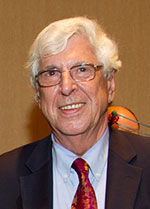Two UH Scientists Named to National Academy of Inventors
Allan Jacobson, Richard Willson Chosen for Scientific, Technological Innovations
Two University of Houston faculty members have been named fellows of the National Academy of Inventors for their contributions to scientific and technological innovation.
The new UH fellows are Allan Jacobson, director of the Texas Center for Superconductivity at UH and Robert A. Welch Chair of Science, and Richard Willson, Huffington-Woestemeyer Professor of chemical and biomolecular engineering. Both have appointments within the College of Natural Sciences and Mathematics with Jacobson appointed to the Department of Chemistry and Willson to the Department of Biology and Biochemistry.
“At a time when society is interested in ensuring that universities make good use of public resources, this offers recognition that the work our faculty is doing has provided benefits far beyond the campus boundaries,” said Rathindra Bose, vice president for research and technology transfer at the University of Houston. “Although educating students and creating new knowledge remain our highest priority, we also are committed to producing work that improves the lives of people in our community.”
Jacobson and Willson were among 170 people elected as National Academy of Inventors (NAI) Fellows, representing 114 universities and governmental and nonprofit research institutes. With the new fellows, membership in the NAI has grown to 414, including 21 Nobel Laureates.
The new fellows will be inducted March 20 during the annual conference of the National Academy of Inventors at the California Institute of Technology.
Those elected to the rank of NAI Fellow are named inventors on U.S. patents, nominated by their peers for outstanding contributions to innovation in areas such as patents and licensing, innovative discovery and technology, significant impact on society and the support and enhancement of innovation.

Allan JacobsonJacobson, who also holds appointments as professor of chemistry and chemical engineering,
came to UH in 1991 after 15 years at Exxon Corporate Research Laboratories, where
his research focused on lithium batteries and developing catalysts for hydro-treating
and hydrocarbon oxidation.
While at Exxon, he discovered a new class of cathode materials. He also discovered and developed a novel class of catalysts to be used in removing sulfur and nitrogen from hydrocarbons.
At UH, Jacobson’s research has included the discovery of new microporous crystalline metal silicates, a group of compounds with potential applications as catalysts, supports, adsorbents, drying agents and ion exchangers. He later discovered that a microporous metal organic framework, vanadium benzenedicarboxylate, could be used to remove sulfur compounds from gas or liquid streams. That is now being evaluated for commercial use.
Jacobson has 48 issued U.S. patents, with a pending patent for a technology he developed to extract rare earth elements from electronic waste. Rare earth elements are used in cell phones, computer hard drives, catalytic converters, wind power generators, energy efficient lighting and other “green” technologies.
A team of students from the Wolff Center for Entrepreneurship in the UH Bauer College of Business developed a business plan for that technology and won several competitions earlier this year, including first place at the national Department of Energy contest in Washington, D.C. The team has launched a business startup based on the technology.
Jacobson noted that the National Academy of Inventors includes several researchers from the Texas Center from Superconductivity.
“There are many very distinguished people on that list, including some of my own colleagues,” he said. “It’s an honor to be associated with them.”

Richard WillsonWillson, who also has an appointment as a professor of biochemical and biophysical
sciences, studies nanotechnology and biomolecular technologies in medical diagnostics
in an effort to recognize disease at an earlier stage, when treatments are more effective.
He has been issued 16 U.S. patents since joining the UH faculty, with another 13 pending patents, according to the University, and said his total number of patents, including pending foreign patents, is about 80.
The NAI recognition is based on a body of work; among Willson’s highlighted innovations are his co-invention of the first technology for single-molecule DNA sequencing, which led to a UH spinoff company, VisiGen Biotechnologies, headed by Susan Hardin. Several other UH faculty members were also involved in the company, which was acquired by Life Technologies in 2008; Willson was chief technology officer.
In all, he has been involved with five startup companies, either directly or as an advisor.
While much of Willson’s work has focused on biotech, he also is well-known as the sole inventor of a catalyst testing process which allows for the rapid testing of multiple chemical reactions at once. Although that work was done in the 1990s, the technology continues to be used by most major chemical companies. The core patent has been referenced by 105 other U.S. patents and has led to at least 10 active U.S. patents and a large number of foreign counterparts.
Willson is a fellow of several other prestigious professional societies, including the American Association for the Advancement of Science, the American Chemical Society and the American Institute of Medical and Biological Engineering.
But he said election to the National Academy of Inventors is a special honor, in part because both his father and his son are patent attorneys.
NAI also remains a fairly small group, he noted. “There are some people there that are my personal heroes.”
Previously inducted fellows from UH include Bose; Benton Baugh, mechanical engineering; Paul Chu, a physics professor and chief scientist of the Texas Center for Superconductivity at UH; Dan Luss, chemical and biomolecular engineering; Dmitri Litvinov, dean of the Graduate School and John and Rebecca Moores Professor in the Cullen College of Engineering; Zhifeng Ren, M.D. Anderson Chair Professor of Physics and principal investigator at the Texas Center for Superconductivity, and Venkat Selvamanickam, M.D. Anderson Chair Professor of Mechanical Engineering and director of the Texas Center for Superconductivity’s Applied Research Hub.
- Jeanne Kever, University Media Relations